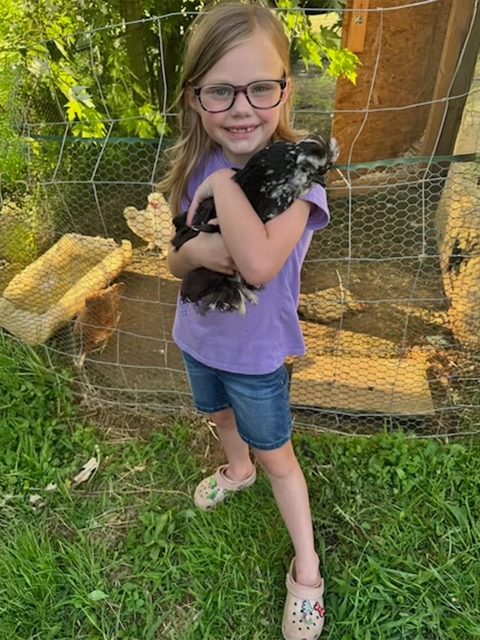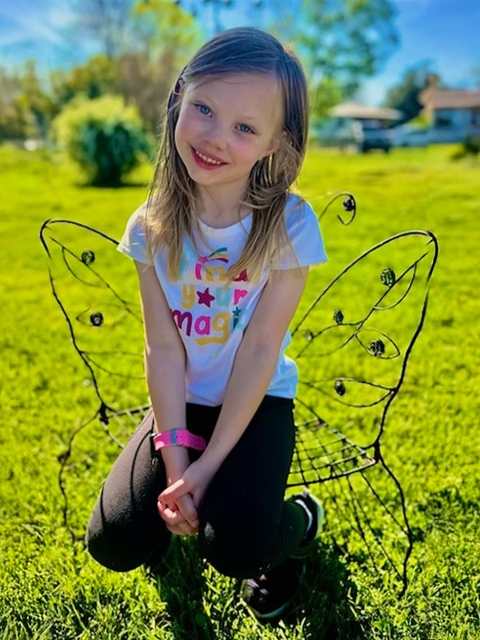Bladder Exstrophy: Cassidy’s Story
Bladder Exstrophy: Cassidy’s Story

Six-year-old Cassidy plays basketball, tends to her four chickens and already reads like crazy as a just-graduated kindergartener. “You would never know anything had been wrong with her,” says her mother, Shae. “She does great.”
Thanks to the Bladder Exstrophy Program at Children’s Hospital of Philadelphia (CHOP), Cassidy is thriving — even though she was born with her bladder on the outside of her body. The condition, called bladder exstrophy, can also affect the urinary tract organs, genitals, pelvic muscles and bones, and, less frequently, stomach muscles, intestines and reproductive organs.
“While this is a scary thing for your child to go through, we see Cassidy improving and improving,” Shae says. “Her doctors in Philadelphia are the reason she’s doing so well.”
CHOP is a world leader in surgery to fix bladder exstrophy. Our doctors utilize the one-stage surgery where a urologist and an orthopedic surgeon team up to fix all the affected areas in a single operation.
Bladder exstrophy is so rare — with 1 case in about 50,000 births — that back in 2012 CHOP teamed up with Boston Children’s Hospital and Wisconsin Children’s Hospital to create the Multi-Institutional Bladder Exstrophy Consortium. With this consortium, Wisconsin’s Michael Mitchell, MD, who popularized the Complete Primary Repair of Exstrophy, became the coach of the CHOP and Boston teams and would watch and critique each surgery. By sharing cases, the surgeons gain more experience, learn from one another and continue to drive research that keeps improving care.
Diagnosis during pregnancy
Shae and her husband, Chris, learned about halfway through the pregnancy that something was wrong.
“We just didn’t know what,” Shae says. “The ultrasounds didn’t show any urine output.”
Later in the pregnancy, when the fetus shifted from a breech to a head-down position, doctors were able to see that the bladder was outside of the abdomen, a sign of bladder exstrophy.
The closest pediatric hospital to their home in Tennessee did very few bladder exstrophy surgeries, so Shae started researching alternative places for care. “That’s how I found the program at Children’s Hospital of Philadelphia,” she says.
The family flew to Philadelphia for a prenatal appointment with pediatric urologist Dana Weiss, MD. “She explained everything, drawing pictures so we knew what to expect,” Shae says. “She was so thorough; she answered all our questions before we could ask them.”
Dr. Weiss also described a future where Cassidy would have a full and active life, “which was different from what we had heard at the other hospital. While there’s always a ‘what if,’ Dr. Weiss was so positive we knew it was well worth travelling to Philadelphia for care,” Shae says.
Local birth, surgery at CHOP
Cassidy was born in Tennessee. Her local doctors worked closely with CHOP’s Division of Urology to make sure her pre-surgery care followed all protocols. When Cassidy was 3 months old, the family, including her 4-year-old big sister Cheyenne, returned to Philadelphia for the one-stage surgery.
After a four-week stay and recovering for another two weeks in Philadelphia, Cassidy was ready to return to Tennessee, and Shae was well prepared to provide the special care she needed at home, including caring for the suprapubic tube, a thin tube from the bladder through the stomach to drain urine. The suprapubic tube was later removed by her home pediatrician.
When Cassidy was 2, she started to develop urinary tract infections. To see in her bladder, the CHOP team brought her to the operating room to perform a cystoscopy, and invited Shae into the operating room as well to show her how to put a thin tube (catheter) into Cassidy’s bladder to drain it. Shae already knew how to catheterize adults from her work as an X-ray technician, “and CHOP taught me the pediatric aspects while she was still sedated, so she wasn’t moving around,” says Shae.
After their bladders are closed, almost all children with exstrophy will have vesicoureteral reflux, condition where urine flows backward from the bladder into the ureters (the tubes that carry urine from the kidney to the bladder) and kidneys instead of flowing normally in the opposite direction. Some children will need to stop that reflux if they are getting infections.
When Cassidy was just over 2, the family returned to CHOP for a more minor surgery: reimplanting a ureter to stop the vesicoureteral reflux that was causing infections. This follow-up surgery is routine in a subset of bladder exstrophy patients. A week later, they were back home.
If a problem arises when the family is at home in McMinnville, TN, about 75 miles southeast of Nashville, Dr. Weiss and the CHOP Urology team work with Cassidy’s local doctors. “Whenever we needed them, her CHOP doctors were ready to help,” Shae says. “Our pediatrician, Dr. Lee Bingham, has been our rock here. If CHOP requests something, like an ultrasound to review, he writes the order, so Cassidy gets whatever she needs.”
Slow but steady progress

As Cassidy has grown, so has her ability to control her bladder and urinate on her own. She still has some leakage, which is normal at this stage of her treatment.
Her parents have always treated Cassidy like any other kid, enrolling her in classes and activities with her peers. Shae stopped by preschool during the day to catheterize Cassidy, making sure her bladder was fully emptied. In kindergarten, Cassidy managed her frequent bathroom breaks on her own. She wears a pad to absorb any leaks, changing it three times a day. But that doesn’t stop her from participating fully in school and other events she wants to do. She still is responsible for her chores, like feeding her chickens and gathering their eggs.
Most recently, her Bladder Exstrophy Program team added a new medication and started physical therapy to strengthen her pelvic floor as treatments to help Cassidy improve bladder control, also called continence.
As an inquisitive 6-year-old, Cassidy asks about her condition and “why I have this,” her mother says. “We tell her she’s super special and as she gets bigger, her problem will get smaller.”
Dr. Weiss assures the family that Cassidy is on track to gain full continence. Research indicates that gradual bladder growth and strengthening the muscles that control holding and releasing urine result in improved function in the long term. “We hope with this ‘slow and steady’ approach, she will have durable results for a lifetime, not just the immediate present,” Weiss says. Cassidy should be able to have children in the future, but she may opt for a c-section birth to preserve her pelvic muscle control.
Keys: Educating yourself and practicing patience
Shae emphasizes that families facing bladder exstrophy need to learn as much as they can and expect ups and downs on their child’s healthcare journey. Be open with family members, childcare providers and teachers, and provide basic education about bladder exstrophy to help normalize the child’s fluctuations in bladder control.
“Advocate for any accommodations your child needs at school and fill out the medical form. Reach out to the school to see what resources are available,” she says.
“We always told Cassidy and her siblings about what was going on, explaining things as many times as we needed to,” she says. “Sometimes Cassidy gets embarrassed, if she has an accident or has to carry a pad into the restroom, so we talk about it. I believe a child will be as normal as the parent treats them. Cassidy is a normal kid in all the ways that matter. She even has a kindergarten boyfriend. You can’t get more normal than that.”